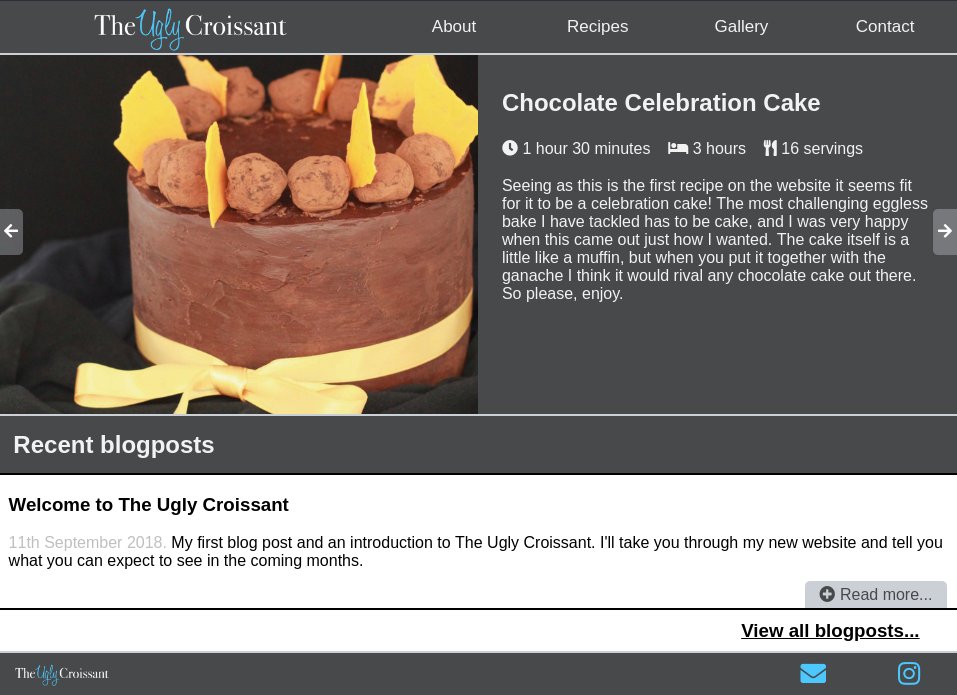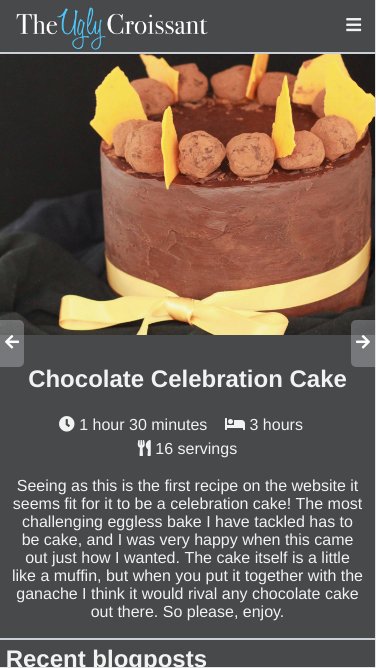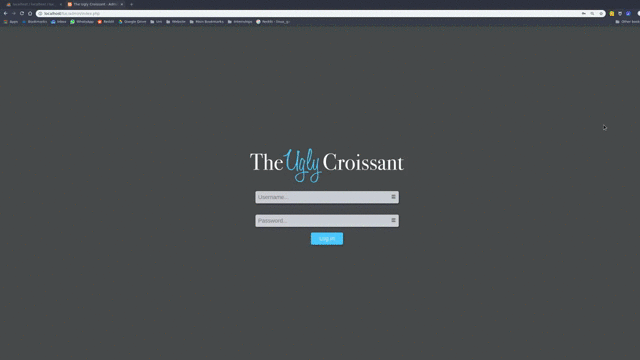The Ugly Croissant
Posted to site: 20/09/18
The Ugly Croissant presented the opportunity to learn the fundamentals of the web, focusing on responsive design. I used PHP to produce a basic content management system which could handle both recipes and blog posts, and implemented a tagging system to help organise the content. Throughout the process I worked closely with the client to get the design right for her and her audience.
Technologies used
- HTML
- CSS
- JavaScript
- jQuery, jQuery UI
- PHP
- MySQL
- Git with GitHub
Development Approach
From the start of the project, responsive design was at the top of the agenda. The client had already amassed a following on social media and was seeking a website in order to grow her presence and display her recipes to her followers. As such, the website had to be designed with a mobile first approach from day one as the vast majority of traffic would be mobile. This was achieved through the use of the viewport meta tag, CSS media queries and CSS grids.


Whilst the blog only has one author, it was still necessary to create a scalable solution to allow for content to be effortlessly published on the website. This is achievable with a static site through a smart naming scheme and structured file system. However, storing the content on a database and using PHP to load the content posed a much more robust, scalable solution. Moreover, this would allow for easier implementation of features such as recipe tagging, searching and commenting in the future. Also, using PHP would help prevent repeated code in the website, thus saving work and making it easier to change the site throughout development and in the future.
Workflow
From the outset I used Git and GitHub for version control, this provided an invaluable tool for managing the codebase for the site, especially in the early days when both author and developer were working together on the site. Moreover, when I eventually started migrating the site to use the database, this allowed us to maintain a working static version of the site alongside the main development, should the author want to publish that site earlier. Development was done largely on my local Linux machine, running XAMPP for a basic local web server and using Atom for text editing.
Early Development
As this was my first web development project, I started out by creating a static site using basic HTML, CSS and some JavaScript. This allowed us to develop both the aesthetic design for the website and the structure behind the content. We arrived at the initial design for the website, and decided that content would be classified as either a blog post or recipe. This gave me the framework around which I could build the database and server-side logic.
At this point, the website could have gone live; although it was missing some features, the content was displayed almost exactly as it would be in the final version. The website was certainly not scalable as publishing a new post required copying and editing previous posts into a new folder then adding the relevant links to other pages. However, the client had not yet finalised the content they wished to publish so we decided to start development of the database and server-side logic.
Database Approach
After considering the various options, I decided on using PHP for the server-side logic and MySQL for storing the content. This website is not designed to produce a large revenue so would likely be hosted on a shared hosting platform. The majority of these platforms provided MySQL databases and PHP without any additional setup or cost so this was the clear choice. Moreover, PHP provides easy, secure communication with databases through the PDO extension which was used throughout the project and protects against SQL injection attacks through prepared statements. In addition, the language is well documented through the PHP Manual and the large, well-established community.
This approach also enabled us to implement a tagging system for the recipes, allowing users to more easily search for recipes relevant to them. Implementing this system presented a design decision as there were a number of approaches to take, each with their own strengths and weaknesses. Phillip Keller has completed tests on the performance of each of these approaches which proved an invaluable resource. Recipes are written rarely, therefore the main focus was on maximising performance for SELECT queries since these would be much more frequent and impact user experience. Thus, based on the expected distribution of our tags, we decided on a three table schema; one for recipes, one for tags and one for tag-maps which list which recipes have which tag (named the “toxi” approach in the linked article). Note, this is also the approach used by Wordpress.
Pagination and Object-Oriented PHP
With all of the recipes and blog posts stored and tagged in a database, this allowed me to create a search page where users could search the site for recipes that interested them. However, returning these results on one page would lead to long page load times and a cumbersome experience for the user. To solve this issue, we needed to automatically paginate the results from the relevant database query. Aware that this was a common problem that might arise on future projects, I created a tool for paginating results from a database query. Using an object-oriented approach, this tool is highly portable and can be integrated into any site in the future. View the PHP Paginator on GitHub.
Object-oriented programming was a much more organised approach to writing PHP, and taking the time to write portable code such as this will definitely pay off in the long run. Within this project, the paginator class was used on multiple occasions to organise results from the database.
Admin Section
At this stage, a basic form for writing recipe and blog post entries had been created, but editing and deleting posts, as well as adding tags, had to be done manually within phpMyAdmin. Although the client was technically literate, this was not ideal and certainly not a long-term solution. The next step of the project was to create an admin section for the website, which would be password protected and provide full control over the content. To implement this, PHP sessions were used to identify logged in users and user information was stored in a MySQL table with passwords salted and hashed using PHP’s standard password_hash() function.
To collect recipe content, the new entry form features three Markdown editors using SimpleMDE, allowing the author to tailor the introduction, ingredients and method of the recipe. Markdown was chosen as it allows the author to focus on writing the content, and prevents any issues arising from asking the author to write in unfiltered HTML. This Markdown is converted into safe HTML by Emanuil Rusev’s Parsedown and the two formats are stored in the database. This allows the content to be quickly loaded to the website, whilst allowing for future editing of the original Markdown.
One standout feature of the user interface is the tag system; when publishing a recipe or blog post, the author is able to add tags to their post. This is accomplished through an AJAX live search box which searches the database for pre-existing tags as the author types. The first step was to create a PHP file which accepts the query through the GET method and echoes a table of results from the database. Then, when the contents of the search box are updated, a HTTP request is made to this file and the content received is embedded into the page. This provides a seamless experience for the author as there are no page reloads, making tags quicker and easier to add before posting.

Lessons Learned
This project provided a great opportunity to develop my understanding of the fundamentals technologies of the web; HTML, CSS and JavaScript. Moreover, I had the opportunity to learn PHP and MySQL which are fantastic tools for quickly creating dynamic sites capable of scaling to accommodate more content. Learning about the basics of security was a valuable experience, as I had to ensure the site was protected against common attacks such as SQL injection and cross-site scripting.
Working with PHP had its strengths and weaknesses, the language offers excellent integration with databases out of the box, making it ideal for web development. The massive community, and manual make troubleshooting relatively painless in most cases. The dynamic typing of PHP allows the developer to spend less time dealing with pedantic issues such as changing the type of a single variable throughout an entire code base. However, static typing makes for inherently more rigorous code which reduces the likelihood of careless errors at the cost of writing arguably over-verbose code. Moreover, using the naive approach to PHP development of basic scripts nestled amongst HTML, code can quickly become disorganised and difficult to maintain.
If using PHP in a larger future project, I would attempt to use an object-oriented approach from the start as it allows the developer to foster a more organised code base which is more manageable as the project grows. Moreover, using a PHP framework such as Laravel would allow for swifter, more elegant coding, through greater conformity to the MVC pattern which is prolific in modern web development. On a similar note, in order to create a more organised style sheet, I would use a CSS pre-processor such as SCSS for its nesting and logic. The front-end codebase of this project was intentionally small to reduce the load on mobile devices so JavaScript frameworks were avoided. However, in larger projects, more dependent on their front-end, the power of JavaScript frameworks makes them an attractive option.
Update
We have since redesigned and rewritten The Ugly Croissant. The whole site is new hosted for free on Netlify, using Netlify CMS for content management.